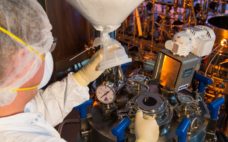This webcast features: Mike Johnson, Business Development Engineering Manager, Life Sciences Puncture strength, haze, Tg, extracts and permeation rates are all single-use bag attributes about which end-users want data. While these are important characteristics, they are polymeric material properties that may or may not indicate actual bag performance. Ultimately, an end-user wants to know that the single-use bag will not put their process fluid at risk. In this study, single-use bags with different gas permeation rates were filled with a…
Sponsored Content
How to Overcome Validation Challenges in a Single-Use World
While the popularity of single-use systems (SUS) is increasing, regulation of SUS supply chains is not. With increased regulatory scrutiny on supply chain security and risk mitigation strategies throughout the development and manufacturing of a therapeutic drug product, end users are scrambling to find ways to ensure the expected level of compliance. The solution? Sharing responsibilities across the entire supply chain. Validation must begin at the component raw material level and continue to final assembly. Primary parties – including drug…
Purification of Antibody Fragments and Single Domain Antibodies With Amsphere™ A3 Protein A Resin
The standard capture purification of full-size, classical antibodies is typically performed with Protein A affinity chromatography. Binding of the Protein A affinity ligand to the “Fc” region of antibodies (Abs) (abbreviations are defined at end of paper) takes place at the juncture of the constant domains 2 and 3 of the Ab heavy chains (Lewis et al. 2008). This high affinity binding primarily involves hydrophobic interactions. Antibodies that belong to the same subclass have greater than 95% homologous Fc-regions, allowing…
Achieving Consistent Performance by Managing Raw Material Variability Through Predictive Modeling
The past 30 years have brought significant progress in the design and manufacture of cell culture media as well as in the types of components used. With these advances, the biopharmaceutical industry improved its processes — from producing just a few milligrams of product per liter of culture to ≥10 g/L. Since the early days of microbiology, peptones have been used widely as a basic ingredient of microbial media. In the 1990s, peptones were introduced as a substitute for serum…
Collaborate to Innovate: Shaping the Future Pharmaceutical Manufacturing Landscape
As the demand for new life-enhancing therapies increases globally, the pharmaceutical manufacturing community faces an unprecedented challenge to accelerate speed to market. Keeping up to date on industry trends is critical to maintaining a competitive edge. But how do you actively drive these trends and apply them to your manufacturing processes to bring your innovation strategy to life? Whether you are implementing single-use technologies to reduce costs and increase productivity or expanding your operations in emerging markets, scientific collaboration and…
Insulin Improves Cell Growth and Influenza Yield in a HEK293 Suspension Cell Line
In her “Ask the Expert” webcast on 21 June 2017, Aziza Manceur of the National Research Council Canada (NRC Canada) discussed the benefits of using insulin in bioprocessing. Manceur’s Presentation Canada’s NRC has research facilities across Canada covering disciplines such as aerospace, energy, mining, and medical devices. The NRC serves both the government and the private sector, working with Canadian and international clients. Manceur is based in Montreal with the cell culture scale-up team (in the human health and therapeutic…
Purification of Antibody Fragments with Amsphere™ A3 Protein A Resin
This webcast features: Gerald Platteau, Application Development Engineer, JSR Life sciences Purification of full-length antibodies containing an Fc region relies on Protein A affinity chromatography as the golden standard capture step. The well-known robustness, high selectivity and scalability make it an ideal platform technique, minimizing downstream processing development time to bring new antibodies to market. After monoclonal antibodies (mAbs), various forms of antibody fragments are now becoming the next most important class of protein based therapeutics. These antibody fragments offer…
Purification of Fab and scFv Using High Binding Capacity TOYOPEARL® AF-rProtein L-650F Resin
Protein L based affinity chromatography is used for the capture of antibodies and antibody fragments that do not bind to protein A. Unlike protein A and G, which bind to the Fc region of immunoglobulins (IgGs), protein L binds through interactions with the variable region of an antibody’s kappa light chain. TOYOPEARL AF-rProtein L-650F is an affinity chromatography resin that combines a rigid polymer matrix with a recombinant protein L ligand, which is derived from the B4 domain of native…
CHT Column Packing is Easier
Than You Think
This webcast features: Dr. Mark Snyder, Manager, R&D Applications, Process Chromatography, Bio-Rad Laboratories This webcast presents best practices and guidelines for packing CHT™ Ceramic Hydroxyapatite Media at process scale. CHT, is an easy-to-use mixed-mode chromatography media. It offers cation exchange and affinity interactions. Unlike other chromatography media, CHT is both the ligand and the support matrix. It is used for the purification of numerous types of biomolecules and is considered the gold standard for aggregate removal. This webcast highlight CHT…
Single-Use Powder Containment Solution
This webcast features: David Howes, ILC Dover Learn about modern single-use powder containment best practices and how to reduce cross contamination and airborne particulates.  You will gain insight on how you can increase safety and speed when handling powders. In the study, we will discuss the ease of fill along with dispensing times and product loss. ILC Dover’s EZBiopac® shows a 71% decrease in filling times when measured against an industry standard 2D bag. Due to the non-static film we…









